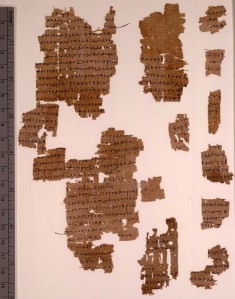Tags
This week’s Ancient World Breakfast Club involved a talk by Max Pappenheim, a former Classics teacher. He delved into the difficulties of the study of Simonides and gave us a chance to work some out for ourselves! I had to do the sign-in for the guests today (writing in when they arrive, taking money – all in the name of security of course) so was unable to make a huge amount of notes.
The ‘honey-toned’ Simonides is probably most well known for the following epigram:
Ὦ ξεῖν’, ἀγγέλλειν Λακεδαιμονίοις ὅτι τῇδε
κείμεθα, τοῖς κείνων ῥήμασι πειθόμενοι.
Stranger, tell the Lacedemonians that we lie here, obedient to their laws/customs.
This epitaph commemorating the Spartans who died at the battle of Thermopylae (the one with Gerard Butler in if you remember) was famously translated/paraphrased into Latin by Cicero (see if you can spot the subtle changes he makes):
Dic, hospes, Spartae, nos te hic vidisse iacentes
dum sanctis patriae legibus obsequimur.
To whom—is specified—
Not murmur—not endearment—
But simply—we—obeyed—
Obeyed—a Lure—a Longing?
Oh Nature—none of this—
To Law—said sweet Thermopylae
I give my dying Kiss—
Ootlin, tell oor maisters this: e lie here deid. We did as we were telt.
Simonides’ poetry
Max moved on to talk about Simonides’ poetry and how difficult it has been to establish authentic and ‘fake’ lines of his. Herodotus verifies some, but even he could be wrong. An anthology was created after his death, but again it is not clear how much of that could have been his. Being on the cusp of the change from oral to written poetry, Simonides may have found his short, pithy statements more resistant to being written down as they are such memorable chunks of poetry.
After the discovery of the Oxyrhynchus Papyri certain fragments were found that could be attributed to Simonides. Max detailed how fragment 11 had been ‘decoded’ and will be published, as the loeb edition just missed out on this connection being made, since it was published in 1992. For a copy click here. He gave us a brief insight into how to piece together papyri, and got us to have a go at guessing what could be missing from the following fragment:
ος λαὸν
όκλου σ’ἄ
Which name is missing from the second line? Answer is at the bottom.
The ‘Poetry Industry’
Pindar calls Simonides a ‘muse for hire’ – Max said that this really summed up the contemporary attitude to Simonides’ poetry. However Max said that this really couldn’t have been considered too strange. If you consider the character of Demodocus from the Odyssey, he was only at the court of King Alcinous because he was receiving board and lodging. This is pre-coinage so was Simonides really doing something so strange?
Max concluded by saying that even though Simonides would write when ‘the price was right’, for example writing different epigrams commemorating both dead Athenians and dead Spartans, the reason for writing becomes insignificant when the quality of his poetry is in front of us.
Next week: Charlotte Higgins, chief arts writer of the Guardian, on ‘Roman Britain from a Camper Van’. After that, half term! Think I’ve earned this one.
Answer: Πατρόκλου (Patroklou)




Pingback: AWBC: Simonides and the Poetry Industry | El Atrio Diario | Scoop.it